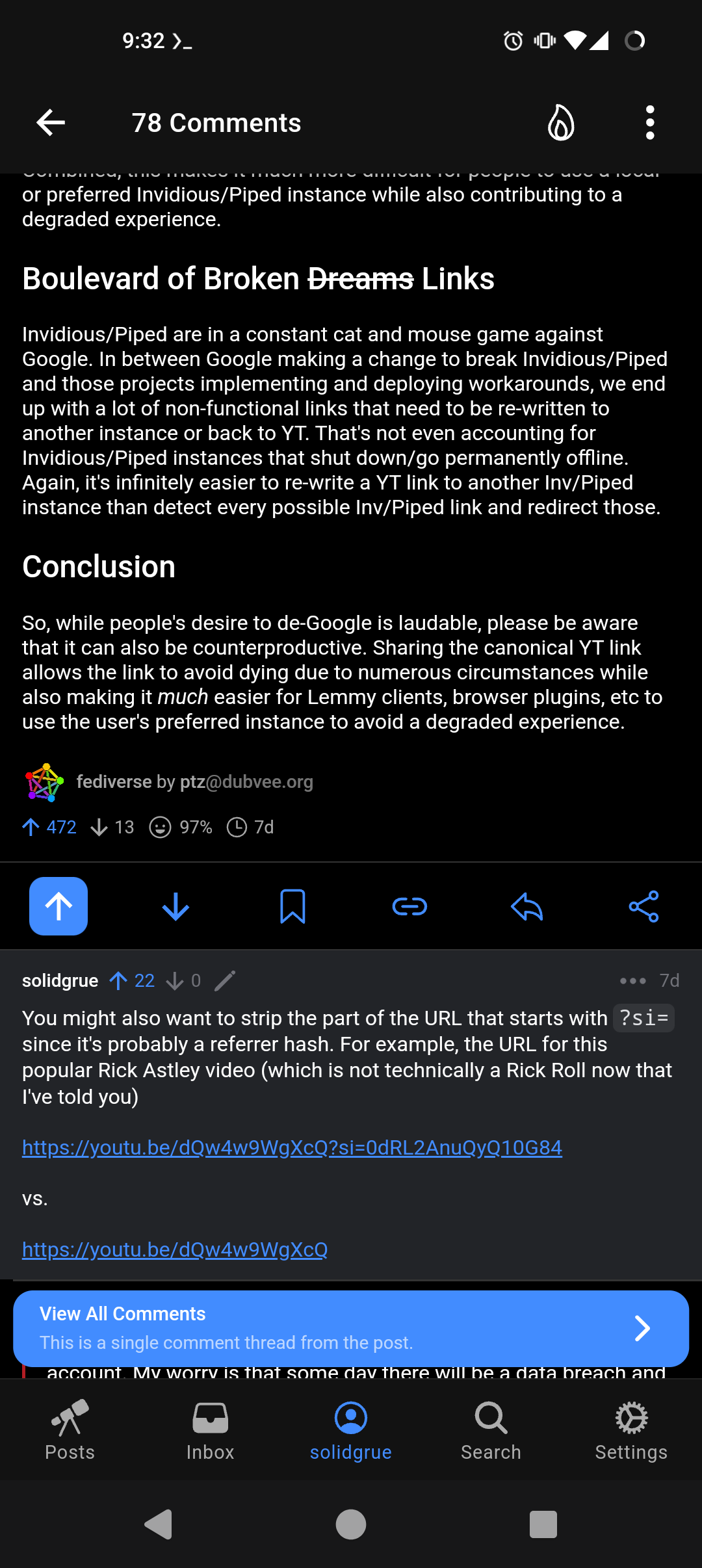

deleted by creator
I’m just this guy, you know?


deleted by creator


deleted by creator


You might also want to strip the part of the URL that starts with ?si= since it’s probably a referrer hash. For example, the URL for this popular Rick Astley video (which is not technically a Rick Roll now that I’ve told you)
https://youtu.be/dQw4w9WgXcQ?si=0dRL2AnuQyQ10G84
vs.
(Edit: for the record…

)


deleted by creator


Usually .world upgrades late in the cycle because they’re big, and also in part because they have an outsized impact on federation issues if any should arise in the upgrade.
Also many similar reasons, but mostly because its prudent for .world to wait


And CSX, but you’re not wrong


deleted by creator


Your alternatives aren’t shelf stable. That’s all there is to it.


When you simmer or slow roast tomato sauce over several hours, the sugars in the tomato release and caramelize which helps to offset acidity. If you’re finding the cooked sauce is still acidic, you can try adding other sweet vegetables such as finely grated carrot, sweet onion, or half of a raw potato (which you’d remove before serving).
That they pack your tomatoes with lemon might mean you need to actively neutralize the extra acids, which you can do with milk or cream, or just a little baking soda as you suggest. Probably not more than a pinch, though, or the sauce could lose its brightness.
Thanks! I hate this. 🖤
Never going in with a Sicilian when death is on the line?


Termux (on F-droid) is a userland environment that runs on top of your Android device’s kernel. It has Debian/Ubuntu-like package management system that pulls from repos maintained by the termux team. If the package is available for aarch64, its probably available in the termux repos. Its not so much of an app as it is an alternate userland that runs on top of the same kernel, but can interact with Android a couple of different ways.
The main Termux app gets you a basic command line environment with the usual tools included in a headless Linux install. From there you can select your preferred repos, do package updates, installs, etc, just like on a desktop or laptop. You could even install a desktop environment and use RDP to access it.
Then there are some companion apps that are useful:
So you could install the syncthing package in Termux and (after setting up Termux access for your internal storage) configure it to sync folders from your phone to wherever syncthing syncs. You’d set up a start script under Termux:boot to launch it when your phone starts, or Tasker to start/stop the service on your home WiFi.


For the F-droid enabled users, it seems there’s a Syncthing app in the Termux repos:
~ $ apt show syncthing
Package: syncthing
Version: 1.28.0
Maintainer: @termux
Installed-Size: 26.4 MB
Homepage: https://syncthing.net/
Download-Size: 7857 kB
APT-Sources: https://packages.termux.dev/apt/termux-main stable/main aarch64 Packages
Description: Decentralized file synchronization


I think that’s the Gen2 or Gen3? I had a couple of them over a few years, and I’m ashamed to say I’m not sure whether I actually had the one in the photo, or the version just prior to it.


I have no specific basis to say so, but I distrust browser-based password managers on the principles of separation of function and mitigating risk. Strong my credentials in a browser just feels hinky, even with a master password. Too obvious of an attack vector. Rather, I use the KeepassDX variant with its MagicKeyboard feature. When I’m presented with a login prompt, I can use the keyboard switcher to launch KeepassDX, unlock my vault, and select the credentials entry. Then I can switch back to the browser (or app) and have MagicKeyboard enter the credentials for me.
It’s a few more taps than just that, but it’s a straightforward workflow that should mitigate leakage from my usual keyboard, clipboard snooping, and any hypothetical attacks against the in-browser vault workflow.
Plus, I know where my credentials are stored, can apply 2FA, and even back up the vault file to offline archives.
It works for me. “Cool story bro,” I guess, is my point.


In the eye of our creators, we are all donuts.
Probably all of them, at one time or another.


deleted by creator


deleted by creator
deleted by creator